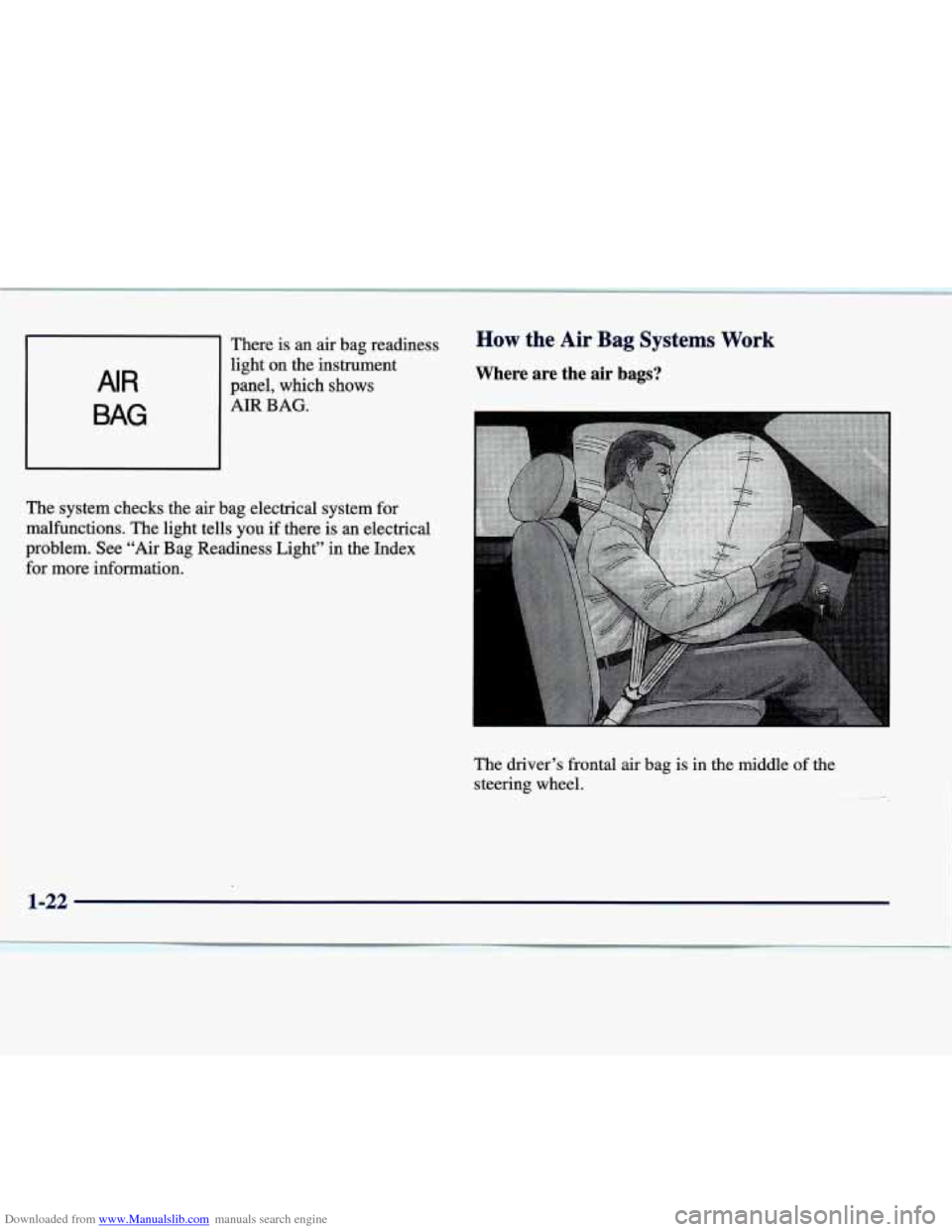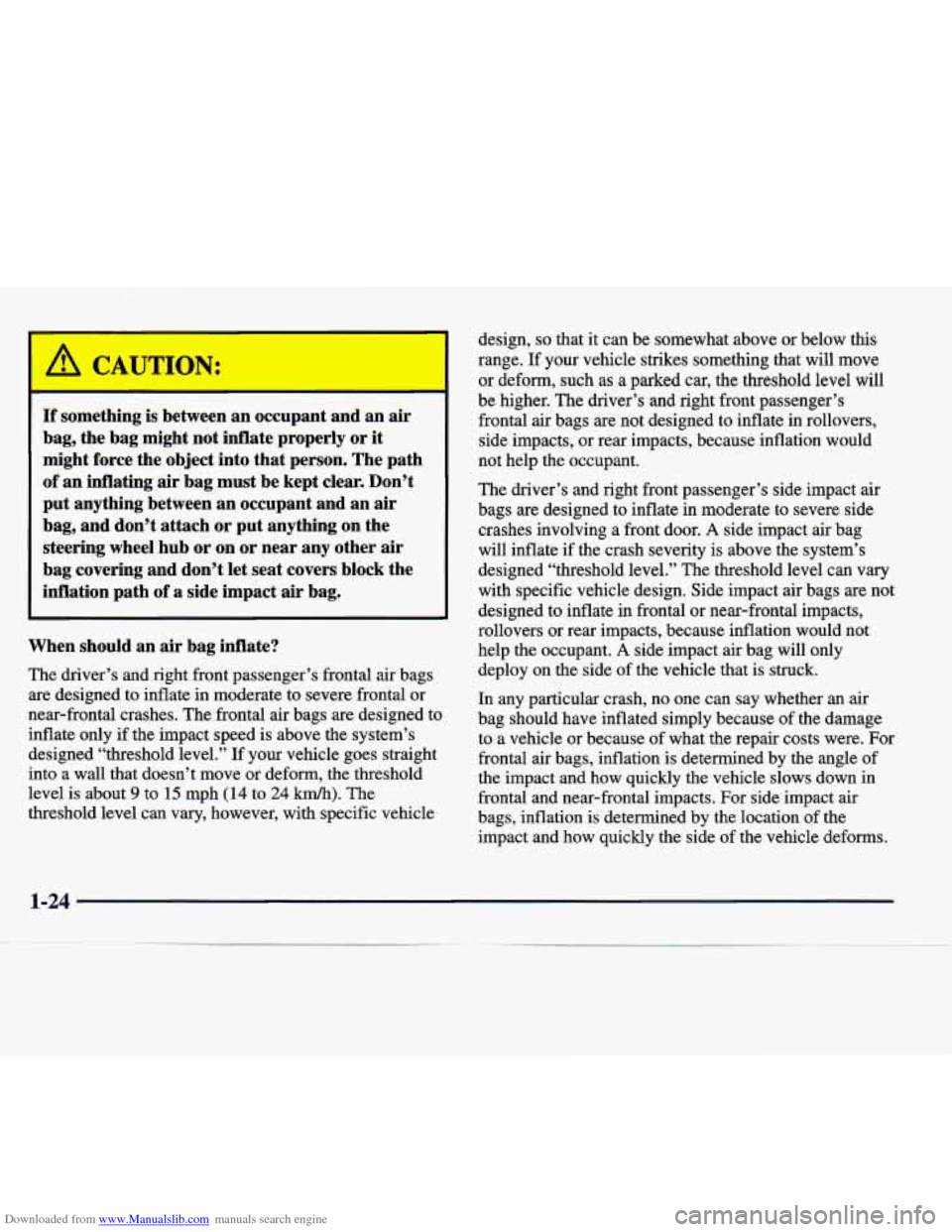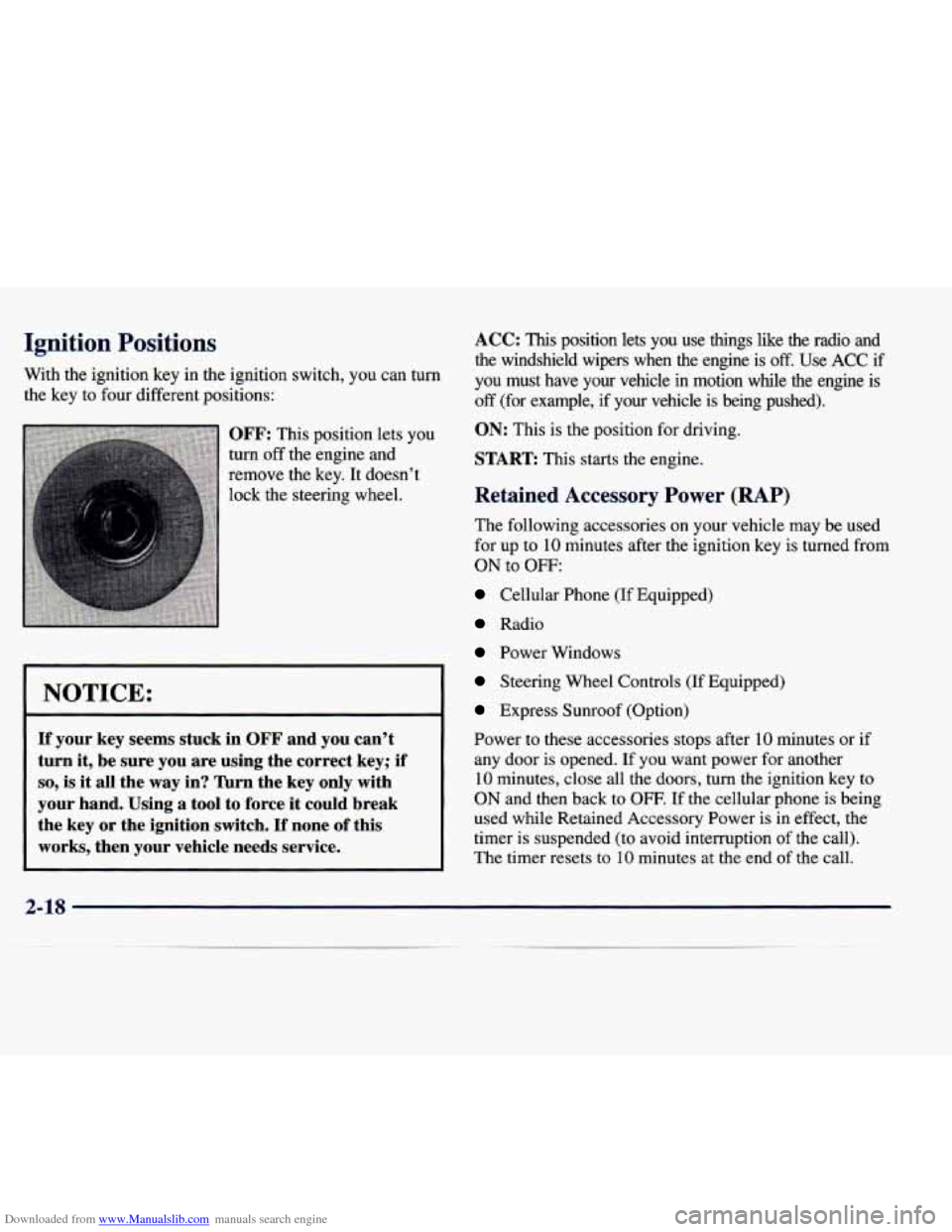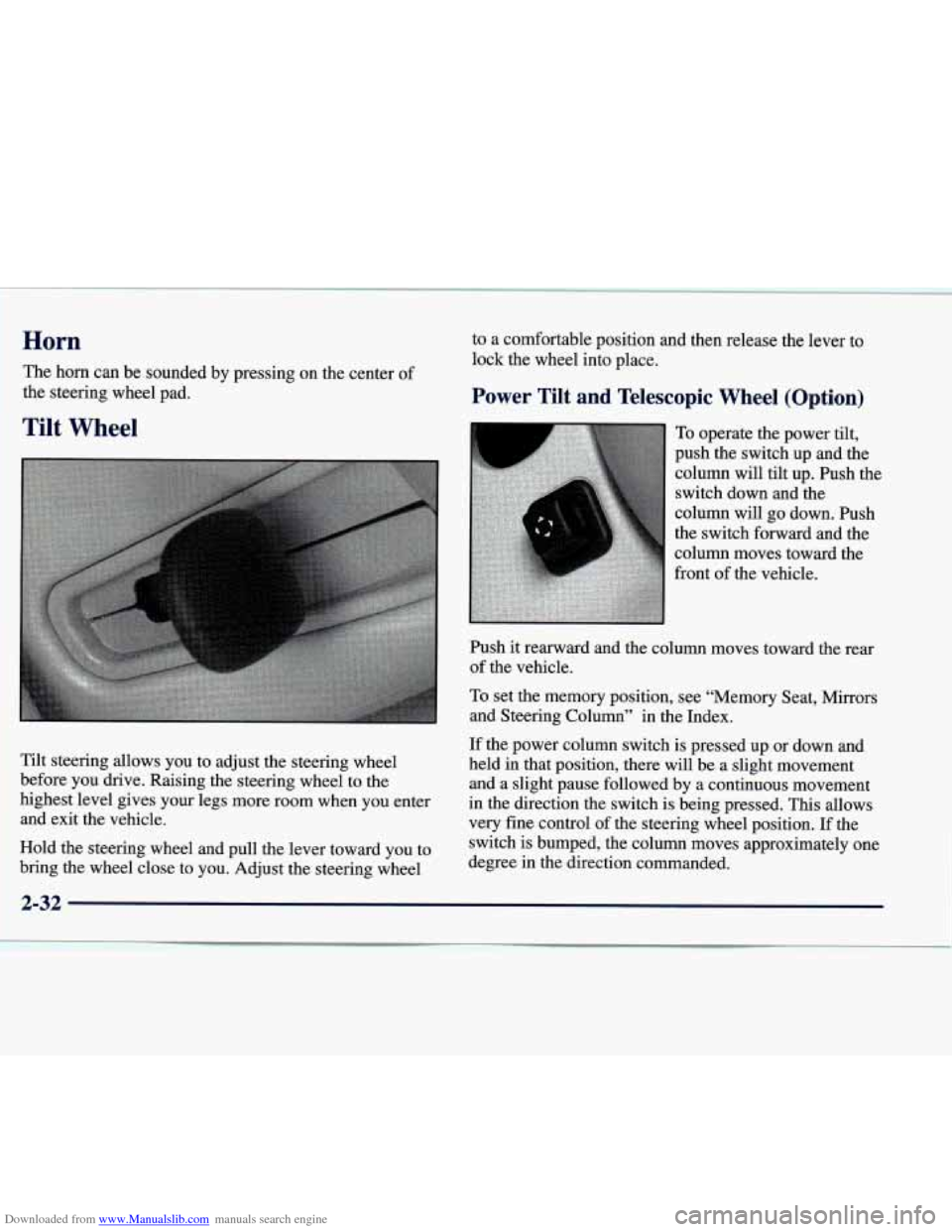1998 CADILLAC SEVILLE steering
[x] Cancel search: steeringPage 14 of 378

Downloaded from www.Manualslib.com manuals search engine Adaptive Seat Control (If Equipped)
The adaptive control is
located
on the
outboard side of each
front
seat. Use the
power seat control first
to get the proper
position. (The lumbar
will automatically
adjust to your body’s
positioning for the
duration of the trip in
four-minute cycles.)
With the ignition on, press the control up to activate the
adaptive seat.
To reshape the lower seatback, press the lumbar
control forward to increase support and rearward to
decrease support.
To turn off the adaptive seat, press the control down.
Memory Seat, Mirrors and Steering
Column
(If Equipped)
2 MEMOffY
SET
The controls for this option
are located
on the driver’s
door panel, and
are used
to program and recall
previous settings.
Adjust the driver’s seat (including the lumbar and head
restraint adjustments), both the outside mirrors and steering wheel column to a comfortable position and
then press the MEMORY SET button. Within five
seconds, press button “1.”
Page 15 of 378

Downloaded from www.Manualslib.com manuals search engine A second &or, seating and column position may be
programmed by repeating the above steps and pressing
button
2. Each time a memory button is pressed, a single
beep will sound through the radio. Each time button
1 or 2
is pressed, the memory positions will be recalled. At the
factory, the exit position is preset with the steering wheel
full up and the seat full back. However, two personalized
exit positions can
be set by first recalling the driving
position (Driver
“1” or “2”), positioning the wheel and
seat in the desired exit positions and then pressing the
MEMORY SET and, within five seconds, pressing the
EXIT button. The exit position for either previously set
driver can
be recalled by pressing the EXIT button.
Heated Seat (Option)
This option is only available if your vehicle is equipped
with the power lumbar control feature.
The front seat controls are
located in the center
console. The rear seat
controls, for the outboard
positions only, are located on the rear door (note that
only the outboard positions
in the rear seats are heated).
Push the button once for a high setting, twice for a low
setting, and a third time to turn
off the heated seat. The
LO setting warms the seatback and cushion until the seat
approximates body temperature. The
HI setting heats the
seat to a slightly higher temperature.
The heated seats can only be used when the ignition is
turned on. The heating elements in the seats
automatically
turn off when the vehicle’s ignition is
turned off.
Reclining Front Seatbacks
The power controls
are located on the
outboard side
of each
front seat. Press the
top of the control
forward or rearward
to adjust the seatback
angle. Push up or
down to adjust the
headrest and shoulder belt.
Page 33 of 378

Downloaded from www.Manualslib.com manuals search engine AIR
BAG
There is an air bag readiness
light
on the instrument
panel, which shows
AIR BAG.
The system checks the air bag electrical system for
malfunctions. The light tells
you if there is an electrical
problem. See “Air Bag Readiness Light”
in the Index
for more information.
How the Air Bag Systems Work
Where are the air bags?
The driver’s frontal air bag is in the middle of the
steering wheel.
1-22
Page 35 of 378

Downloaded from www.Manualslib.com manuals search engine A CAUTION:
If something is between an occupant and an air
bag, the bag might not inflate properly
or it
might force the object into that person. The path
of an inflating air bag must be kept clear. Don’t
put anything between an occupant and an air
bag, and don’t attach or put anything
on the
steering wheel hub or on or near any other air
bag covering and don’t let seat covers block the
inflation path of a side impact air bag.
When should an air bag inflate?
The driver’s and right front passenger’s frontal air bags
are designed to inflate in moderate to severe frontal or
near-frontal crashes. The frontal air bags are designed to
inflate only if the impact speed is above the system’s
designed “threshold level.” If your vehicle goes straight
into a wall that doesn’t move or deform,
the threshold
level is about
9 to 15 mph (14 to 24 km/h). The
threshold level can vary, however, with specific vehicle design,
so that it can be somewhat above or below this
range. If your vehicle strikes something that will move
or deform, such as a parked car, the threshold level will
be higher. The driver’s and right front passenger’s
frontal air bags are not designed to inflate in rollovers,
side impacts, or rear impacts, because inflation would
not help the occupant.
The driver’s and right front passenger’s side impact air
bags
are designed to inflate in moderate to severe side
crashes involving a front door.
A side impact air bag
will inflate if the crash severity is above the system’s
designed “threshold level.”
The threshold level can vary
with specific vehicle design. Side impact air bags are not
designed to inflate in frontal or near-frontal impacts,
rollovers or rear impacts, because inflation would not
help the occupant.
A side impact air bag will only
deploy on the side of the vehicle that is struck.
In any particular crash, no one can say whether an air
bag should have inflated simply because of the damage to a vehicle or because of what the repair costs were.
For
frontal air bags, inflation is determined by the angle of
the impact and how quickly the vehicle slows down in
frontal and near-frontal impacts. For side impact air
bags, inflation is determined by the location
of the
impact and how quickly the side of the vehicle deforms.
1-24
Page 36 of 378

Downloaded from www.Manualslib.com manuals search engine What makes an air bag inflate?
In an impact of sufficient severity, the air bag sensing
system detects that the vehicle is in
a crash. For both
frontal and side impact air bags, the sensing system
triggers
a release of gas from the inflator, which inflates
the air bag. The inflator, air bag and related hardware
are all part of the air bag modules inside the steering
wheel, instrument panel and the side of the front
seatbacks closest to the door.
How does an air bag restrain?
In moderate to severe frontal or near frontal collisions,
even belted occupants can contact the steering wheel or
the instrument panel. In moderate to severe side collisions, even belted occupants can contact the inside
of the vehicle. The air bag supplements the protection
provided by safety belts. Air bags distribute the force of
the impact more evenly over the occupant’s upper body, stopping the occupant more gradually. But the frontal air
bags would not help you in many types of collisions,
including rollovers, rear impacts, and side impacts,
primarily because an occupant’s motion is not toward
the air bag. Side impact air bags would not help you in
many types
of collisions, including frontal or near frontal collisions, rollovers, and rear impacts, primarily
because an occupant’s motion
is not toward those air
bags. Air bags should never be regarded as anything
more than
a supplement to safety belts, and then only in
moderate to severe frontal
or near-frontal collisions for
the driver’s and right front passenger’s frontal air bags,\
and only in moderate to severe side collisions for the
driver’s and right front passenger’s side impact air bags.\
What will you see after an air bag inflates?
After an air bag inflates, it quickly deflates, so quickly
that some people may not even realize the air bag
inflated. Some components of the air bag module
-- the
steering wheel hub for the driver’s air bag, the
instrument panel for the right front passenger’s bag, the
side of the seatback closest to the door for the driver and
right front passenger’s side impact air bags
-- will be
hot for a short time. The parts of the bag that come into
contact with you may be warm, but not too hot to touch.
There will be some smoke and dust coming from the
vents in the deflated air bags. Air bag inflation doesn’t
prevent the driver from seeing or being able to steer the vehicle, nor does it stop people from leaving the vehicle.
1-25
Page 38 of 378

Downloaded from www.Manualslib.com manuals search engine NOTICE:
If you damage the covering for the driver’s or the
right front passenger’s
air bag, or the air bag
covering on the driver’s and right front
passenger’s seatback, the bag may not work
properly. You may have to replace the air bag
module in the steering wheel, both the air bag
module and the instrument panel for the right
front passenger’s air bag, or both the air bag
module and seatback for the driver’s and right
front passenger’s side impact air bag.
Do not
open
or break the air bag coverings.
Servicing Your Air Bag-Equipped Vehicle
Air bags affect how your vehicle should be serviced.
There are parts
of the air bag systems in several places
around your vehicle. Your dealer and the Seville Service
Manual have information about servicing your vehicle
and the air bag systems.
To purchase a service manual,
see “Service and Owner Publications” in the Index.
For up to 10 seconds after the ignition key is
turned off and the battery is disconnected, an air
bag can still inflate during improper service. You
can be injured if you are
close to an air bag when
it inflates. Avoid yellow connectors. They are
probably part of the air bag systems. Be sure
to
follow proper service procedures, and make sure
the person performing work for you is qualified
to do
so.
The air bag systems do not need regular maintenance.
Rear Seat Passengers
It’s very important for rear seat passengers to buckle up!
Accident statistics show that unbelted people in the rear
seat are hurt more often in crashes than those who are
wearing safety belts.
Rear passengers who aren’t safety belted can be thrown
out
of the vehicle in a crash. And they can strike others
in the vehicle who are wearing safety belts.
1-27
Page 79 of 378

Downloaded from www.Manualslib.com manuals search engine Ignition Positions
With the ignition key in the ignition switch, you can turn
the key to four different positions:
OFF: This position lets you
turn
off the engine and
remove the key. It doesn’t
lock the steering wheel.
NOTICE:
If your key seems stuck in OFF and you can’t
turn it, be sure you are using the correct key; if
so, is it all the way in? Turn the key only with
your hand. Using a tool to force it could break
the key
or the ignition switch. If none of this
works, then your vehicle needs service.
- ~
ACC: This position lets you use things like the radio and
the windshield wipers when the engine is
off. Use ACC if
you must have your vehicle in motion while
the engine is
off (for example, if your vehicle is being pushed).
ON: This is the position for driving.
START This starts the engine.
Retained Accessory Power (RAP)
The following accessories on your vehicle may be used
for up to
10 minutes after the ignition key is turned from
ON to OFF:
Cellular Phone (If Equipped)
Radio
Power Windows
Steering Wheel Controls (If Equipped)
Express Sunroof (Option)
Power to these accessories stops after
10 minutes or if
any door is opened. If you want power for another
10 minutes, close all the doors, turn the ignition key to
ON and then back to OFF. If the cellular phone is being
used while Retained Accessory Power is in effect, the
timer is suspended (to avoid interruption of the call).
The timer resets to
10 minutes at the end of the call.
2-18
Page 93 of 378

Downloaded from www.Manualslib.com manuals search engine Horn
The horn can be sounded by pressing on the center of
the steering wheel pad. to a comfortable position and then release the lever to
lock the wheel into place.
Power Tilt and Telescopic Wheel (Option)
Tilt Wheel
If the power column switch is pressed up or down and
Tilt steering allows you to adjust the steering wheel held in \
that position, there will be
a slight movement
before you drive. Raising the steering wheel to the and a sli\
ght pause followed by a continuous movement
highest level gives your legs more room when
you enter in the direction the switch is being pressed. This allows
and exit the vehicle. very fine control of the steering wheel position. If the
Hold the steering wheel and pull the lever toward you to switch is bumped, the column moves approximately one
bring the wheel close to you. Adjust the steering wheel degree in the direction commanded.